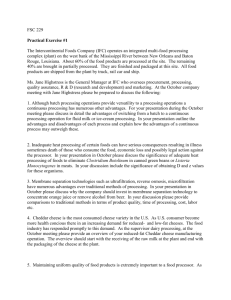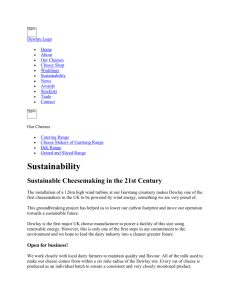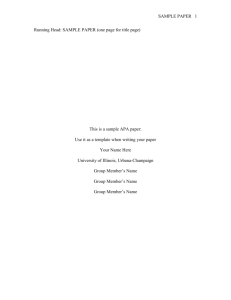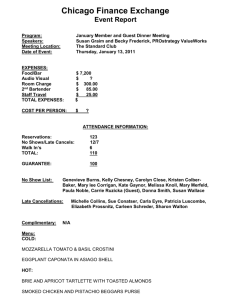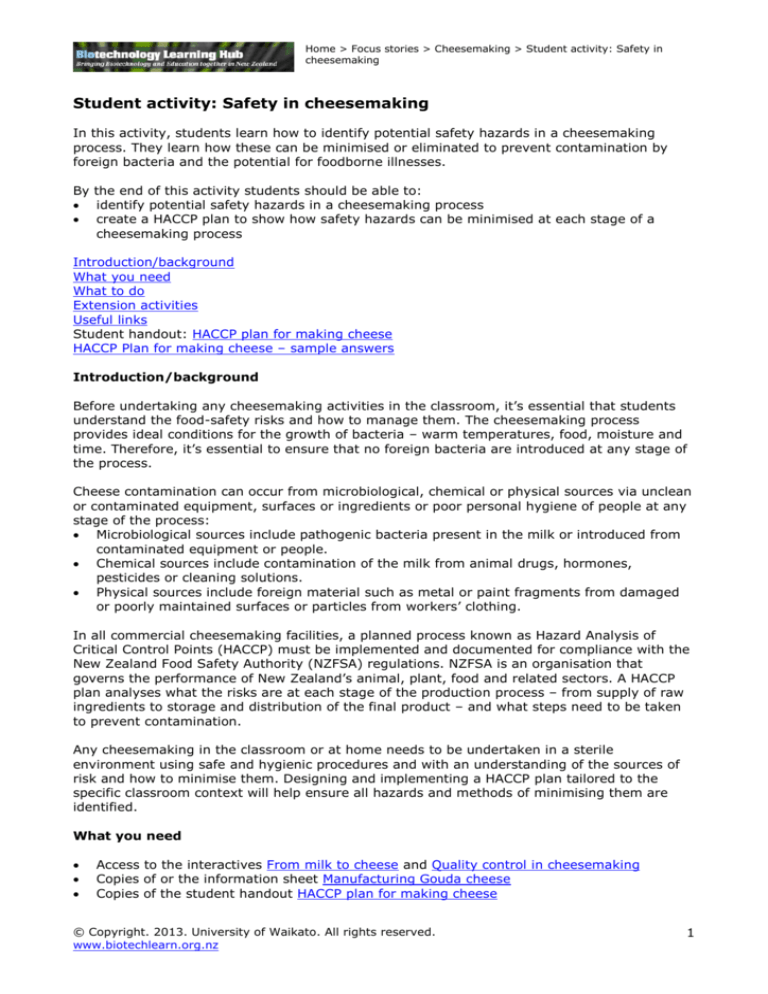
Home > Focus stories > Cheesemaking > Student activity: Safety in
cheesemaking
Student activity: Safety in cheesemaking
In this activity, students learn how to identify potential safety hazards in a cheesemaking
process. They learn how these can be minimised or eliminated to prevent contamination by
foreign bacteria and the potential for foodborne illnesses.
By the end of this activity students should be able to:
identify potential safety hazards in a cheesemaking process
create a HACCP plan to show how safety hazards can be minimised at each stage of a
cheesemaking process
Introduction/background
What you need
What to do
Extension activities
Useful links
Student handout: HACCP plan for making cheese
HACCP Plan for making cheese – sample answers
Introduction/background
Before undertaking any cheesemaking activities in the classroom, it’s essential that students
understand the food-safety risks and how to manage them. The cheesemaking process
provides ideal conditions for the growth of bacteria – warm temperatures, food, moisture and
time. Therefore, it’s essential to ensure that no foreign bacteria are introduced at any stage of
the process.
Cheese contamination can occur from microbiological, chemical or physical sources via unclean
or contaminated equipment, surfaces or ingredients or poor personal hygiene of people at any
stage of the process:
Microbiological sources include pathogenic bacteria present in the milk or introduced from
contaminated equipment or people.
Chemical sources include contamination of the milk from animal drugs, hormones,
pesticides or cleaning solutions.
Physical sources include foreign material such as metal or paint fragments from damaged
or poorly maintained surfaces or particles from workers’ clothing.
In all commercial cheesemaking facilities, a planned process known as Hazard Analysis of
Critical Control Points (HACCP) must be implemented and documented for compliance with the
New Zealand Food Safety Authority (NZFSA) regulations. NZFSA is an organisation that
governs the performance of New Zealand’s animal, plant, food and related sectors. A HACCP
plan analyses what the risks are at each stage of the production process – from supply of raw
ingredients to storage and distribution of the final product – and what steps need to be taken
to prevent contamination.
Any cheesemaking in the classroom or at home needs to be undertaken in a sterile
environment using safe and hygienic procedures and with an understanding of the sources of
risk and how to minimise them. Designing and implementing a HACCP plan tailored to the
specific classroom context will help ensure all hazards and methods of minimising them are
identified.
What you need
Access to the interactives From milk to cheese and Quality control in cheesemaking
Copies of or the information sheet Manufacturing Gouda cheese
Copies of the student handout HACCP plan for making cheese
© Copyright. 2013. University of Waikato. All rights reserved.
www.biotechlearn.org.nz
1
Home > Focus stories > Cheesemaking > Student activity: Safety in
cheesemaking
What to do
1. Start by discussing the key stages and ingredients of the cheesemaking process. Review
what students may already know about the conditions that support bacterial growth, for
example, warm temperatures, moisture, time and food. Ask them about the conditions
present in the cheesemaking process and where there could be risk of bacterial growth.
How could foreign bacteria be inadvertently introduced? How could physical or chemical
contamination occur?
2. Discuss the risk of foodborne illness from cheese. See articles in useful links on
unpasteurised cheese and Listeria food poisoning from cheese.
3. Discuss the concept of HACCP planning – a legal requirement in the food industry to
manage food safety.
4. Divide students into small groups and hand out copies of the information sheet
Manufacturing Gouda cheese and the student handout HACCP plan for making cheese.
5. Have students view the interactive From milk to cheese and discuss in their groups what
the possible microbiological, chemical and physical risks are for this cheesemaking process
at each stage. What procedures do they observe at each stage that minimise the risks?
6. On the student handout HACCP plan for making cheese, have students list the processing
steps, the hazards and the preventative measures at critical control points.
7. When they have recorded their ideas, have them view the interactive Quality control in
cheesemaking and review their HACCP plan.
8. Share group responses with the class, discuss differences and allow students time to
review and adjust their group responses if necessary. (Note that the video clips don’t cover
every possibility so it is possible students could mention valid control measures that are
not included in the video clips.)
Extension activities
If students are going to experiment with or make cheese in the classroom, have them
complete the HACCP plan for that activity or recipe.
Have students research pasteurisation and find out about the debate surrounding raw milk
versus pasteurised milk.
Encourage students to review the regulations around unpasteurised cheese in New Zealand
– see useful links. Students may already be aware of this or know someone who has
suffered a foodborne illness from contaminated cheese. Are they aware that unpasteurised
cheeses are sold in New Zealand now? Are they aware how these unpasteurised cheeses
can be identified? What groups are at risk from these cheeses? Write a report stating and
justifying their views on this change in legislation. Alternatively, prepare an argument for a
debate from the perspective of a key stakeholder in the controversy.
Useful links
Varieties of milk
A description of the composition of the different varieties of milk available.
www.milk.co.uk/page.aspx?intPageID=43
Cheese milk types
A comparison of the use of raw milk and pasteurised milk in cheesemaking.
www.french-at-a-touch.com/Gourmet/Cheese/milktypes.htm
© Copyright. 2013. University of Waikato. All rights reserved.
www.biotechlearn.org.nz
2
Home > Focus stories > Cheesemaking > Student activity: Safety in
cheesemaking
Reviewing rules about raw milk cheese in New Zealand
An article in the New Zealand Herald in 2006 about NZFSA’s review of the rules about raw milk
cheese in New Zealand at the time.
www.nzherald.co.nz/business/news/article.cfm?c_id=3&objectid=10370270
Raw milk cheese in New Zealand
The current status of regulations in New Zealand for production and importation of raw milk
cheeses on the NZFSA website – published 2009.
www.foodsafety.govt.nz/elibrary/industry/More_Variety-Lovers_Applauded.htm
Dairy product manufacture legislation
Learn about food safety legislation for dairy products in New Zealand in downloadable
documents on the New Zealand Food Safety Authority (NZFSA) website.
www.foodsafety.govt.nz/industry/sectors/dairy/documents/legislation.htm
Pasteurisation
Learn about the history, methods and effects of pasteurisation of milk.
www.raw-milk-facts.com/pasteurization_T3.html
HACCP planning for cheesemaking
Download the PDF to learn more about Hazard Analysis of Critical Control Points (HACCP)
planning for cheesemaking.
www.internetjfs.org/articles/ijfsv10-1.pdf
Food safety and cheese
Read about food safety and cheese on the Dairy Research and Information Center (UC Davis,
University of California) website.
http://drinc.ucdavis.edu/dfoods5_new.htm
Reducing Listeria risk in cheesemaking
Read these news articles to learn more about the risk of cheese contamination from Listeria
monocytogenes and preventative strategies.
www.foodproductiondaily.com/Processing/Plant-design-and-personal-hygiene-crucial-toreducing-listeria-risk
http://digitaljournal.com/article/316110
© Copyright. 2013. University of Waikato. All rights reserved.
www.biotechlearn.org.nz
3
Home > Focus stories > Cheesemaking > Student activity: Safety in cheesemaking
HACCP plan for making cheese
Cheesemaking Identify the hazards – microbiological (M),
steps
chemical (C), physical (P)
M
Pasteurisation C
P
M
Coagulation
C
P
M
Cutting
C
P
Releasing the
M
whey
C
P
M
Moulding
C
P
M
Brining
C
P
M
Coating
C
P
M
Maturing
C
P
M
Packaging
C
P
© Copyright. 2013. University of Waikato. All rights reserved.
www.biotechlearn.org.nz
Describe preventative measures at critical control points
4
Home > Focus stories > Cheesemaking > Student activity: Safety in cheesemaking
HACCP plan for making cheese – sample answers
Cheesemaking Identify the hazards – microbiological (M),
steps
chemical (C), physical (P)
M Survival of pathogenic bacteria.
Pasteurisation C Contaminated milk.
P
Coagulation
Cutting
Releasing the
whey
Moulding
Brining
Coating
Maturing
Packaging
M
C
P
M
C
P
M
C
P
M
C
P
M
C
P
M
C
P
M
Inadequate growth of starter bacteria.
Contamination of rennet or starter bacteria.
Contamination from unclean cutting blades.
Chemical residues from sanitisers on equipment.
Foreign particles from cheesemakers’ clothing or cutting blades.
Optimum moisture content of the curd.
Contamination from workers or unclean moulds.
Chemical residues on moulds.
Contamination from workers’ clothing and mould materials.
Salt concentration inadequate to prevent spoilage.
Contamination of the salt.
Foreign particles in the salt.
Coating protects from microbiological contaminants.
Impurities in the coating material.
Coating protects from physical contaminants.
Contamination from moisture and mould growth on surface;
environmental hazards such as pests or rodents.
C
P
M Contamination from cutting equipment, surfaces or workers;
C
P
incorrect storage temperature.
Contamination from inappropriate packaging materials or chemical
residues on equipment or surfaces.
Introduction of foreign particles from cutting equipment, surfaces
or workers.
© Copyright. 2013. University of Waikato. All rights reserved.
www.biotechlearn.org.nz
Describe preventative measures at critical control points
Check temperature and time (72 °C, 15 seconds) and adjust setting if needed.
Sanitise all equipment.
Monitor quality of milk supply – test for chemical contaminants.
Check freshness and storage temperature of starter bacteria and rennet.
Proper sterilisation of vat and equipment.
Proper personal hygiene and handling.
Correct measure of starter bacteria and temperature for growth and/or pH test.
Check time and temperature settings of cheese vat, curd size and consistency.
Measure pH.
Proper sterilisation of cutting blades.
Proper personal hygiene and handling.
Check temperature setting of cheese vat.
Monitor amount of whey released.
Proper personal hygiene and handling.
Clean, white clothing and hairnets.
Proper sanitising and rinsing of cheese moulds.
Check purity of salt before use.
Test brine saturation level.
Check time in brine bath.
Coating applied as soon as brined cheese is dry.
Check source and quality of coating supply.
Sufficient number of coats applied to protect cheese.
Monitoring temperature and humidity levels in maturing room.
Turning and wiping cheeses daily.
Maturing room kept clean, well maintained, closed and pest-free.
Proper sterilising of surfaces and equipment for cutting the cheese.
Workers wear clean, white clothing, aprons, hairnet, gumboots – worn only in
cheesemaking area.
Proper personal hygiene of workers.
Use appropriate plastic for packaging.
Monitor correct refrigeration temperatures.
5


